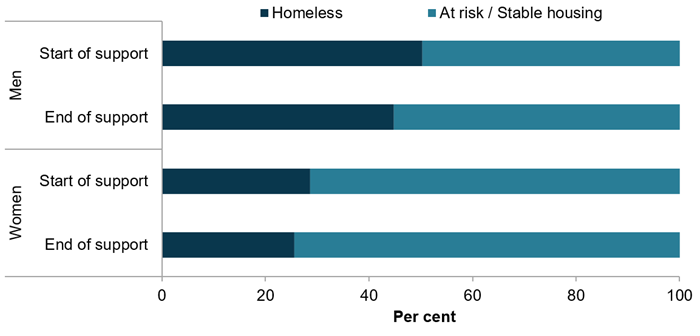Differences by sex
Key findings
- A higher proportion of ex-serving men were homeless at the start and the end of support, compared with ex-serving women.
- Men had a higher need for, and use of, accommodation services compared with women.
- More than half of women needed domestic and family violence services during the 6-year reporting period.
- Ex-serving clients discharged from the Air Force had lower levels of homelessness at the start and end of support (compared with Army and Navy clients).
Of the 1,215 ex-serving Australian Defence Force (ADF) specialist homelessness services (SHS) clients who used SHS between 1 July 2011 and 30 June 2017, 941 (77%) were men. The proportion of men among ex-serving ADF SHS clients was lower than the proportion among ex-serving members who were not clients (85%). The proportion of women among ex-serving ADF SHS clients (23%) was higher than among ex-serving members who were not clients (15%).
Despite this higher likelihood to use SHS, a lower proportion of ex-serving women were homeless at both the start and end of support, compared with ex-serving men (Figure 8). At the start of support, 29% of women were homeless, compared with 50% of men. At the end of support, the proportion of women who were homeless remained largely unchanged at 26%. This was still much lower than the proportion of men homeless at the end of support (45%). This is consistent with the results for the general Australian population of SHS clients, where men using SHS are more likely to be homeless and women are more likely to be at risk (AIHW 2019).
Figure 8: Ex-serving ADF SHS clients, housing situation at start and end of support, by sex, 2011–12 to 2016–17

Notes
- The data for housing situation includes all clients, regardless of whether all of their support periods have been closed.
- Percentages for housing situation have been calculated using the total number of ex-serving ADF SHS clients as denominator, excluding those whose situation was not stated.
- Housing situation at the start of support is the housing situation of a client during the financial year in which the client first received SHS support. Clients at the start of support are categorised as either homeless or at risk of homelessness.
- Housing situation at the end of support is the housing situation of a client during the financial year in which the client last received SHS support. Clients at the end of support are categorised as either homeless or in stable housing.
Source: AIHW analysis of linked PMKeyS–SHSC data 2011–12 to 2016–17; Table S7.
Results for female ex-serving ADF SHS clients indicate a lower need for accommodation and a higher need for other services:
- A lower proportion of ex-serving women used accommodation services (31%), compared with men (40%).
- 53% of ex-serving women indicated that the main reason for seeking assistance at the start of support was interpersonal relationship reasons (including domestic and family violence, and relationship or family breakdown), compared with 12% of men.
- 53% of ex-serving women were assessed as needing domestic and family violence services at some point during the 6-year reporting period. Of those that needed these services, 95% were provided with them by their SHS agency.
There are a number of differences that may reflect the higher proportion of men who were homeless at the start of support:
- 44% of ex-serving men indicated that accommodation was their main reason for seeking assistance at the start of support. This is higher than for women (22%), and may reflect the higher proportion of men who were homeless at the start of support.
- 27% of ex-serving men indicated their main reason for seeking assistance at the start of support was financial, compared with 19% of women.
- 68% of ex-serving men identified a need for accommodation of any kind, compared with 49% of women.
- 50% of ex-serving men identified a need specifically for short-term accommodation, compared with 37% of women.
References
AIHW (Australian Institute of Health and Welfare) 2019. Specialist homelessness services annual report 2017–18. Cat. no. HOU 299. Canberra: AIHW.


